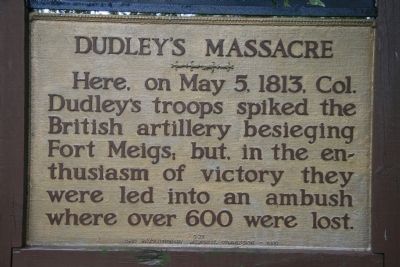It was on the fifth of May that the Americans suffered a particularly bloody and unnecessary defeat known as “Dudley's Defeat.”
The defeat, also known as “Dudley's Massacre,” involved military brilliance and bungling, cowardice and bravery, and a manifestation of the violence that often accompanied life in America's early days.
It occurred during the first siege of Fort Meigs during the War of 1812.
On the night of May 4, 1200 reinforcements, consisting mostly of new Kentucky recruits under the command of General Green Clay, neared the fort. Harrison sent instructions to Clay to send a detachment of 800 men to surprise-attack the British batteries at dawn the following morning.
 |
| Fort Meigs |
The objective was to spike the cannons, rendering them useless, and hurry to the safety of Fort Meigs before British reinforcements could arrive from Fort Miamis, which was just downriver (about the 1800 block of River Road at Michigan Avenue, today).
The detachment, led by Colonel William Dudley, attacked the British battery at dawn, carrying out their mission successfully. However, the events that followed led ultimately to Dudley's defeat.
Instead of returning to the fort as planned, the raw recruits, exhilarated by their success, pursued some straggling Indians into the forest (“every Kentuckian is crazy at the sight of an Indian,” the old history books say). Dudley and his officers tried vainly to stop them but were futile in their efforts and joined in the fray.
The trap had been set. For the Americans to pursue them into the forest was exactly what the Indians wanted. Once they had reached an area where the Maumee Library now stands, the British and Indians counterattacked.
A fierce battle ensued, lasting several hours. The Americans attempted to retreat toward the river but found themselves cut off
When the battle was over, about 220 of Dudley's men lay dead, while 350 were captured. About 200 managed to make their way across river and back to Fort Meigs. Colonel Dudley was killed during the battle and scalped.
 All that remains as reminders of the carnage that took place in May of 1813 are the preserved sites of Fort Meigs and Miamis, and a historical marker in front of the Maumee Library on River Road.
All that remains as reminders of the carnage that took place in May of 1813 are the preserved sites of Fort Meigs and Miamis, and a historical marker in front of the Maumee Library on River Road.Keep 'em caching,
Jason Hubbard
Want more Maumee, Ohio history? Click here.

Thanks for posting this. Also, thanks for creating your Educaching manual.
ReplyDeleteI will be teaching using GPS technology for the first time this fall. I am excited about all the planning I will be doing this summer. Your manual will help tremendously.